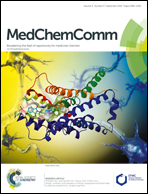2-Aminobenzimidazoles as antibiofilm agents against Salmonella enterica serovar Typhimurium†
Abstract
Serovars within the species Salmonella enterica are some of the most common food and water-borne pathogens worldwide. Some S. enterica serovars have shown a remarkable ability to persist both inside and outside the human body. Salmonella enterica serovar Typhi can cause chronic, asymptomatic infection of the human gallbladder. This organism's ability to survive inside the gallbladder centers around its ability to form biofilms on gallstone surfaces. Currently, chronic carriage of S. Typhi is treated by invasive methods, which are not well suited to areas where Salmonella carriage is prevalent. Herein, we report 2-aminobenzimidazoles that inhibit S. enterica serovar Typhimurium (a surrogate for S. Typhi) biofilm formation in low micromolar concentrations. Modifications to the head, tail, and linker regions of the original hit compound elucidated new, more effective analogues that inhibit S. Typhimurium biofilm formation while being non-toxic to planktonic bacterial growth.



 Please wait while we load your content...
Please wait while we load your content...